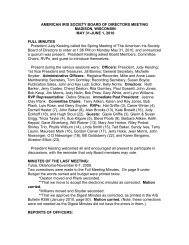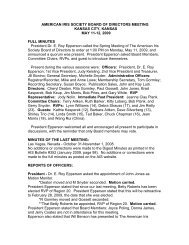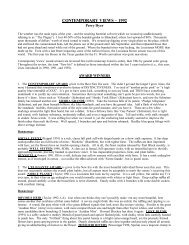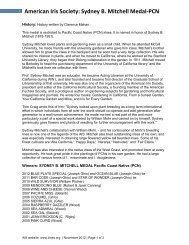contemporary views – 1988 award winners - American Iris Society
contemporary views – 1988 award winners - American Iris Society
contemporary views – 1988 award winners - American Iris Society
Create successful ePaper yourself
Turn your PDF publications into a flip-book with our unique Google optimized e-Paper software.
floodlight! Fortunately, I pushed to get everything planted and the glad bulbs dug before I left for Lafayette the first<br />
weekend in November for the <strong>Society</strong> for Louisiana <strong>Iris</strong>es (SLI) Board Meeting. While I was gone, the temperature in<br />
Oklahoma City dropped (plummeted) to 11 degrees. And it was 30 degrees in south Louisiana! Miss Kitty kept saying<br />
we were in for an early, long, hard winter; even she was surprised it came so soon.<br />
It will be very apparent, as you read this year’s review, what kind of season we had, by seeing where the emphasis is.<br />
The median season was very good, and many crosses were made. Then the rains came <strong>–</strong> right in the middle of the Tall<br />
Bearded season. The TBs were very lackluster, and the rot that had started last fall kicked in again. I got fed up with<br />
them, dug everything up (medians too) and started all over this summer. I guess all the spring rain turned out to be a<br />
blessing for some things, because the Louisiana bloom was the best I’ve experienced in my 15 or so years of growing<br />
them. The Taylor introductions were especially dazzling. Never have I seen such magnificent bloom. The daylily bloom<br />
<strong>–</strong> only my second season <strong>–</strong> was exceptional.<br />
There are not that many new TBs reviewed this year and, with a few exceptions, I see no reason to repeat those reviewed in<br />
previous years. I’m not a rich man, and I could not/would not spend those French Riviera prices to attend this year’s<br />
national convention. And from the looks of things, I won’t be attending the Atlanta Convention either. Fortunately, we<br />
see a lot of the newest and best right here in Oklahoma City each year.<br />
There will be a heavy emphasis on medians, and with 1500 guest plants now residing in 8 tour gardens for the Sooner<br />
State <strong>Iris</strong> <strong>Society</strong> (SSIS) “Median Spree in ‘93”, you’ll be seeing more reviewed the next few years. Over 50 hybridizers<br />
have sent guests to our median convention. The Blanchard garden will be on tour with 132 guests planted.<br />
The Australian Louisianas were so outstanding that a separate article is being written for publication in the SLI newsletter,<br />
titled “State of the Art: An Assessment of Australian Cultivars”, but will be included with this review as an addendum.<br />
Contemporary Views’ <strong>award</strong> <strong>winners</strong> are reviewed first, then TBs by general color group, then medians by class, a couple<br />
of arilbreds, and last but not least, those unforgettable Louisiana wonders. Throughout the review, the term “New <strong>Iris</strong>” is<br />
defined as those introduced within the last 3 years inclusive (i.e., this year, irises introduced in 1989, 1990, and 1991).<br />
AWARD WINNERS<br />
1. The CONTEMPORARY AWARD, given to the Best New <strong>Iris</strong> seen, goes to APOLLO’S SONG (Taylor 1991).<br />
What a fantastic new Louisiana! A first-year plant produced 2 tall 50” stalks with show branching of 4 well spaced<br />
branches, wide enough to allow the moderately large flowers to open and expand with ease. Plenty of buds, and opens 2<br />
and 3 at once. This creamy butter-yellow was the king of the patch, with strong stalks that held up beautifully (unusual for<br />
this color range). Clean colors with no other infusions to contaminate the effect, lightly ruffled, and completely sunfast,<br />
with tough leathery texture and outstanding substance. Extremely vigorous, husky plants with plenty of increase.<br />
Surprisingly, a child of ‘Screen Gem’ (Arny) X ‘Helen Naish’ (Taylor).<br />
Runnersup:<br />
RASPBERRY FUDGE (Keppel 1989) was a Contemporary Award runnerup last year also. I continue to be impressed<br />
with its notable resistance to rot, excellent plant habits, and superb branching and bud count. Worthy of the top HM this<br />
year in the suspiciously-sparse group of <strong>winners</strong> (with only 16 <strong>winners</strong> out of 884 eligible TBs, something is terribly<br />
wrong somewhere). This is the best, overall, of the Keppel warm plicatas. A vivacious medley of rich raspberry,<br />
chocolate, and sienna colors, artfully arranged on a cream background. ROSETTE WINE (Schreiner 1989) was a surprise<br />
for me. This rich tapestry of rose cerise has a white area radiating from the heart of the flower (similar to what the<br />
Schreiners call their “zonal” pattern, but the light area is not quite full enough to meet their definition). Magnificent show<br />
stalk branching <strong>–</strong> a great one to have to “save the show” when we have those early bloom seasons, for it blooms very late<br />
in the season. Beautiful foliage, and the plant habits appear to be much more dependable than some of the predecessors<br />
from this bloodline. KUNIKO (Gatty 1989) was highly thought of even while still a seedling and continues to impress.<br />
Remindful of Joe’s earlier introduction, the popular ‘White Lightning’, except that ‘Kuniko’ is a cleaner, “colder” white<br />
and has prettier, heavier lace. But the bright yellow beard really makes the flower, as with ‘White Lightning’. The<br />
difference is that ‘Kuniko’ blooms later in the season and won’t fall victim to our notorious late Okie freezes, which<br />
unfortunately, the very fine ‘White Lightning’ was so susceptible to because of its extremely early season of bloom and<br />
tender growth. I was shocked when ‘Kuniko’ didn’t even make the HM list this year, for it is one of Gatty’s finest<br />
creations <strong>–</strong> ever!<br />
40
















